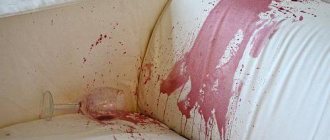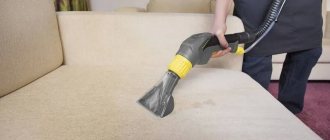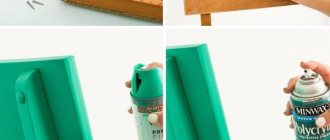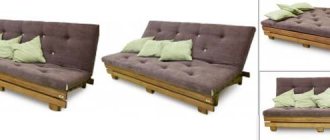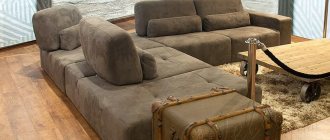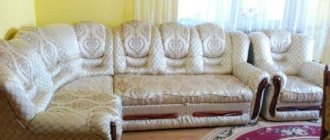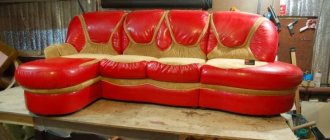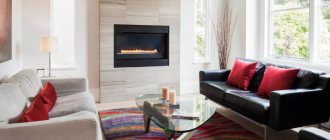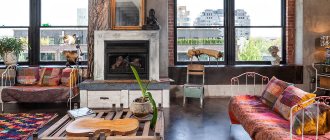PVC profile for framing the ends of chipboards
Along with conventional edges, PVC edging is used to frame the ends of chipboard.
As a rule, it is used in places of high humidity, high risk of mechanical damage, or based on design decisions. A distinctive feature of PVC edging from PVC edges is that it is made immediately for a specific slab thickness, where trimming of excess width is not allowed. The most common width sizes are 16.18 and 32 mm.
Also, the installation technology of this profile does not allow it to be joined at the corners. For example, in order to edge two adjacent ends, you need to round the corner (at least along the very minimum radius).
Types of PVC profiles
- Overhead (U-shaped) Hard
- Flexible
- No girth
U-shaped edging
Working with such PVC edging for furniture is not at all dusty, and you can even do it at home.
Hard “click and done”
Used for edging straight edges of chipboard. It is also possible to edge the ends of chipboard with a small rounding radius. The only tools needed are your hands and the edge itself. Just snap the profile onto the end and you're done. And the side ends are closed with special plugs.
It is precisely because of this installation method that people love it. But it also has its drawbacks, which manifest themselves in the inability to edge rounded (radius) parts.
Flexible
This edging can be used as furniture edging for lining the ends of chipboard, both straight and rounded. For installation you will need a sharp knife and good glue. If there are concerns about moisture penetration, use silicone sealant in excess instead of glue.
To improve adhesion between the edge and the end of the chipboard, the inner surface of the profile can be scratched in different directions with a sharp object (knife, screwdriver, scissors).
The rigidity of this profile is also affected by the room temperature. Therefore, it is recommended to stuff it in a warm room, where it becomes softer and more “obedient.”
Everything else is simple. Apply glue or sealant to the inside of the edge and glue it to the end of the chipboard. Iron it thoroughly and also remove excess glue. We trim the edges of the edging only after two hours of exposure, when the glue has set. Well, complete drying of the glue will occur only after one day.
You can trim the excess profile to length with a sharp knife or garden pruning shears.
PVC mortise T profile
T-shaped edging is quite often used in the manufacture of modern furniture. This is not surprising, since it has a number of undeniable advantages:
- Chic appearance (structural, matte, glossy and reflective surfaces),
- Sturdy mount
- Hides chips and unevenness at the ends of the slab,
- Easy to install on complex parts with both outer and inner radius.
The only disadvantage of the PVC T-profile is the need to mill a groove. For milling, we will need a hand router with a 2.8-3 mm cutter, as well as a special room, since there will be a lot of dust, and we don’t need that at home.
But still, this minus is not so terrible as to completely abandon this type of edging of the ends of chipboard.
Types of T-profile
Mortise T-shaped profile can be:
It can also be:
The mortise T-shaped profile with a girth (with antennae) is quite popular. It is especially popular when edging curved and radius parts that were cut with an electric jigsaw (in these cases it is simply irreplaceable).
When choosing a mortise edge, give preference to a rigid profile. Do not take a soft edging; you will suffer a lot with it both during installation and when using the part itself.
The fact is that the soft mortise edge is quite flimsy and when driven into the groove, its leg will bend and break very much. Even if you fill it properly, it will constantly bend back, thereby always getting debris under it. Also, all the potholes and unevenness of the end will be visible under it. And this will negatively affect the overall appearance of the product.
Types of PVC profile
- Mortise (frame T)
- With girth
- No girth
- Invoice (form P)
- Flexible
- Hard
U-shaped overhead profile
This edging is easy to process, so it can be used at home.
Hard – easiest to use
This type of fittings is suitable for working with chipboard ends with a small rounding radius. No special tools are required to process it. The profile simply snaps onto the end and the job is done. For the side ends there are plugs with which they are secured.
Due to its simple installation, many people use this type of edging. But it cannot be used to edge radius parts, and this is its main disadvantage.
Flexible profile
This type of material is widely used for cladding the ends of rounded or straight chipboards, and is often used in kitchen furniture. During the installation process, a sharp knife and reliable glue are used. In case of moisture penetration, the glue is replaced with a large amount of silicone sealant.
In order to guarantee high-quality adhesion between the end and the edge, the surface of the profile inside the structure is scratched with a sharp knife or screwdriver. The rigidity of the profile will depend on the internal temperature of the room. For this reason, it is recommended to use it exclusively in a warm place where the material will be “obedient”.
We recommend: Laminated particle board
The process itself is extremely simple. Sealant or glue is applied to the inside of the edge and glued to the end of the chipboard. Excess glue is wiped off and the structure is carefully ironed. The structure is kept for two hours, after which the excess at the edges is cut off. The glue will dry completely only after a day, so the material must be allowed to dry. For pruning, use pruning shears or a garden knife.
T-shaped mortise type PVC profile
T-type edging is widely used in furniture production. It has a number of advantages that make it a quality material:
- Aesthetic appearance (matte, glossy, structured and reflective surfaces)
- High quality fasteners
- Easy installation on any complex part
- The material hides unevenness and chips on the ends of the slabs
The disadvantage of this material is the requirement for milling a groove. For this, a manual type milling cutter with a cutter measuring from 2.8 mm to 3 mm is used, as well as a place where the procedure can be carried out due to the large amount of dust. In any case, this is a small drawback against the background of a large number of advantages.
T-shaped profile and its types
The T-profile can have a girth and be soft or hard. It fits well under kitchen facades. A mortise edging without a girth is used infrequently, since with its help the end is not hidden reliably enough, and is also not protected from debris and moisture.
The T-shaped profile with a girth is more popular. It has antennae, which are useful for radius and curved parts created using an electric jigsaw. In such cases, the use of any other profile is not permitted.
Often, after a part has been cut with a jigsaw with an insufficiently high-quality cutting blade, ospreys appear on the surface of the end. A furniture edge will not hide such imperfections. For this reason, it is envisaged to use a T-shaped mortise edge, which has antennae. The longer these antennae are, the better for the structure.
When choosing a mortise edging, you should give preference to a rigid type profile. You should not take a soft edging, since it can cause quite a lot of wear and tear during installation and subsequently when using the part itself.
The problem with soft edging is that it is extremely soft and its leg bends and breaks during the process of hammering into the groove, so I do not recommend using it in the production of kitchen furniture. Even if it is filled normally, its bending is inevitable, which will cause debris to clog under it. In addition, potholes will be noticeable underneath. Unevenness in the end will result in spoiling the aesthetic appearance of product designs. The most optimal solution would be a hard edge in the shape of the letter T with large antennae.
We recommend: Tools for making furniture
Installation of a mortise T-edge
For installation we will need:
- Manual electric router,
- Edge cutter with a tooth thickness of 2.8-3 mm and a depth of at least 10 mm,
- Rubber hammer.
The first step is to make a high-quality groove at the end of the chipboard. It should be located strictly in the center (16 mm in the slab - exactly 8 mm from the edge).
We make the groove with a cutter with a tooth thickness of 2.8-3 mm. For reliable fastening, the width of the groove should be 0.5-0.7 mm less than the thickness of the tenon (T-leg) of the edge, and the depth should be at least 10 mm.
Before stuffing the T-shaped PVC profile, the end must be cleaned of chips and sanded with sandpaper.
When driving the edge into the groove, bend the profile towards you. This is done so that the antennae do not rest against the edges of the end, but immediately wrap around it on both sides.
If you are putting edging on parts with a large outer radius, for example, on a rounded corner, then in order for the profile to fit normally and not form an “accordion” in the leg, you need to make a cutout in it.
When stuffing, use only a rubber mallet! With a regular hammer you will simply ruin the edge.
If you use PVC edging with a reflective surface, the protective film should be removed after completing all installation work, only on the finished product.
The video below shows the operation of the machine for milling the end for installation of a mortise T-shaped edge:
And here is a semi-automatic machine for driving in a T-shaped edge:
Source
What is
In the production of furniture structures, fittings play an important role. With its help, parts can be combined into a single system or used for finishing finished products. A furniture profile is a fitting made by rolling, bending, casting, stamping - depending on the properties of the source material. The semi-finished product has important advantages:
- decorative function - a variety of colors, shapes, materials of manufacture plays an integral role in the design of products, determines the general style of the furniture ensemble;
- structural component - the furniture profile performs the function of a supporting and connecting element, serves as a frame for filling the facades with MDF panels, wood, veneer, glass;
- protection from mechanical damage - thanks to the clear dimensions of the profiles, it is possible to maintain the strict geometry of furniture facades, countertops, doors, mirrors;
- durability of products enclosed in a furniture profile. Structural elements are protected from moisture on the ends and edges, the structure of the facades and compartments is preserved;
- low weight - the fittings are made from lightweight materials, so the products do not load furniture elements, do not weigh down the product, but at the same time have high mechanical strength.
Furniture profiles are produced as molded semi-finished products of various sections, sizes, and shapes. Depending on the purpose, there are frame-type options for facades, overhead cornices, end caps for tabletops, guide elements for sliding wardrobes, handles, frames, strips, edge products, modules for drawers, beds.
Purpose
In the manufacture of cabinet furniture, similar elements are widely used, which simultaneously perform decorative, protective and supporting functions. The use of profiles allows us to produce factory products and produce furniture according to individual drawings. Purpose of furniture profiles of various types and designs:
- façade - frame structures made from furniture profiles are filled with glass, mirror panels, plastic, MDF boards, and natural wood panels. A durable frame base is used in the manufacture of kitchen sets, furniture for bedrooms, living rooms, children's rooms, corridors, and wardrobes;
- overhead cornice - products of different reliefs are used for decorative decoration of the upper parts of cabinets. Cornices have a front side, a cut and a back part, and can be solid or glued together from several pieces. Widely used for finishing furniture according to individual drawings;
- side trims - such profiles are used for front processing of kitchen countertops. Mortise products act as a protective edge, prevent moisture and dirt from entering the end surface of the tabletop, and give the details an aesthetically attractive appearance;
- connecting, fastening, end strips. The fittings are used to secure furniture parts without the use of glue. At the same time, functional products protect the edges of countertops, facades, and panels from moisture, debris, and dirt. The end strips perform a decorative and protective function;
- profile for sliding systems. Used in the production of door structures for sliding wardrobes. Using a closed or open profile, door panels are framed; a separate type of fittings is a handle profile, thanks to which it is easy to move the panel along the guide rails.
The use of protective-decorative and connecting-supporting profiles of various shapes and designs makes it possible to implement non-standard design solutions, as well as hide the gaps between furniture elements.
If the furniture is made without decorative legs, the gap between the bottom of the structure and the floor is closed with a base made of moisture-proof laminated chipboard or MDF (according to the body material). To extend the service life of the plinth, a water-repellent profile can be installed underneath the sealant to prevent water from entering the plinth.
APPLY MODERN INDIVIDUALS!Catalog of furniture components
| Catalog of accessories for car seats | |
| Currently, it is difficult to imagine high-quality furniture without the use of special materials and elements that influence the construct, manufacturability and design. One of the modern high-tech products used in the production of upholstered furniture are foamed polyethylene profiles. The range of profiles offered covers a wide range of production operations and allows you to solve a number of such important problems as: • hide defects in the wooden frame; • give the furniture an original design without major structural changes to the frame; • protect the fabric from abrasion; • hide the hardware seam; • make the tensions even; • maintain its original appearance for a long time. The profiles used in the production of upholstered furniture not only help solve many technological problems associated with improving the quality of upholstered furniture and improving its aesthetic characteristics, but also facilitate the work of personnel, speeding up the production process due to the simplicity and cost-effectiveness of installation. Most profiles are fixed to the frame thanks to the basic principle of fastening used in upholstered furniture - using staples and pneumatic tools, or glue. All this increases the production culture, and at the same time the company’s prestige as a high-quality and reliable manufacturer of upholstered furniture. The wide range of German products includes such items as edging profiles, flexible edges, staple strips, profiles for staple seams, belts for backs and seats, hinge strips and many other products necessary to ensure that your finished furniture is on an equal footing with products from European manufacturers. | The automotive industry today is one of the most high-tech industries in the global reproduction chain. Therefore, the most modern achievements of science and technology are used here. We have the opportunity to offer you plastic profiles and fastening systems for seat covers and head restraints to metal frames. The wide range of products produced allows us to implement the most complex individual technical and design solutions, and also provides the opportunity to obtain such advantages as:
is one of the world's leading active partners in the development of the automotive industry. Whose business is the development, production and sale of plastic profiles and system solutions for securing car seats. By constantly improving technology, increasing the quality and environmental friendliness of its products, Oke keeps pace with the progress in seat fastening safety and high seating comfort. By setting new standards and shaping trends, Oke has earned the trust of all well-known car manufacturers. |
Why is re-upholstery needed?
At first, the car was regarded as a luxury item, due to its high cost and rarity, but a little later the conveyor belt and other technological innovations turned it into a means of transportation accessible to everyone. And now the car has also become a means of expressing individuality.
Almost anyone can buy a car; due to such accessibility, it is quite difficult to stand out from the general traffic flow. But, if you use the artistic taste of professional designers and the skills of experienced craftsmen, you can embody part of your own inner world in the exterior and interior of your iron horse! The exterior pleases the eye only when you are outside the car, but a real car enthusiast is more often inside the car, which means that the view he observes while driving is more important to him. It is precisely in this case that the reupholstery of the interior and the new covering of car seats must be at a high professional level. Even if you don’t try to come up with a unique interior interior and use a material such as leather as a new upholstery for car seats, then even the ordinary interior of a not very expensive car will look more solid!
Let's get used to good things!
Of course, it may seem to some that reupholstering the interior is a fairly simple matter, and anyone can handle it with the right amount of patience. However, this is a misconception. Any automotive specialist, be it Moscow or Ufa, will tell you that this is a complex technical process, which does not only involve the fact that your seats will be “re-dressed”. Sometimes, to customize the car’s interior, these seats even have to be slightly modified. You may need not only leather, but also oke components for reupholstering car seats. Fortunately, you will find everything here, even components for upholstering leather interiors of cars, boats and yachts, oke components for the production and reupholstery of upholstered furniture, components for reupholstering chairs and sofas. So we definitely remove the issue of components and materials. After all, the oke brand is used even when it is necessary to produce components for upholstery of furniture, as well as the interior of boats, yachts and cars. The oke brand has proven itself to be excellent; oke furniture components are used for reupholstering sofas and chair seats in many famous tuning studios in cities such as St. Petersburg, Yekaterinburg, Nizhny Novgorod, Kazan, Omsk, Rostov, Samara, Novosibirsk, Volgograd and many others!
Even if we don’t talk about tuning, oke furniture components are used in chairs, armchairs, sofas, interiors of boats and yachts, which are produced all over the world! So, when you rely on the oke Brand, you can have complete peace of mind knowing that you are choosing the best in the segment!
Where else can you show your individuality?
So, we found out that whether it’s Tomsk or Rio de Janeiro outside your car window, the oke brand is an excellent component for upholstering car seats. But sometimes the designer’s thought goes further and you want to transform not only the seats of your car, but also smaller interior details! Modern production of finishing materials has already solved this issue! And now, even if your hometown is Saratov or Blagoveshchensk, you can also transform the steering wheel, instrument panel, door panels or gear shift knob! Parts and materials used for tuning the interior of your car can be found as easily as components for furniture. As a result, all you need to transform the interior of your car is at least a modest imagination, a great desire and a small investment, the investment of which will delight you every time you get behind the wheel!
Manufacturing materials
Profile fittings are made from materials of different structures, resulting in flexible and rigid furniture elements. Due to this, it is possible to process rectilinear and curved parts, and perform edging of complex elements. Basic materials for the manufacture of furniture profiles:
- Aluminum is a lightweight metal of high strength and has a long service life. By adding copper, silicon, silver, manganese, zinc, magnesium, and titanium to the alloy, it is possible to obtain a profile that is resistant to corrosion, chemical and mechanical stress. Aluminum fittings have the required ductility; to protect them from damage, the metal is covered with a special film. The predominant colors are gold, silver, champagne, there are shades of wood and bright colors;
- MDF furniture profile. The products are made from medium-density fiberboard with a coating that imitates various types of natural wood. The fittings are distinguished by ease of installation, a wide range of colors, pleasant texture, environmental friendliness and durability. MDF products are lined with PVC film, natural veneer, and eco-leather. Execution options: frame, support, inlaid profile, cornices, overlays, fittings for insertion;
- PVC profile for furniture. Plastic material is used to decorate the ends of MDF and chipboard panels. The edging made of polyvinyl chloride has a flexible structure, it can be of overhead and mortise type of installation, it can be with or without a girth. The main advantage is ease of installation, wide range of colors. PVC profile allows you to hide the aesthetic imperfections of furniture, prevents the ends of chipboards and fiberboards from getting wet and swelling from moisture.
Anodized aluminum, plastic and MDF are the main materials for the manufacture of furniture profiles. Less commonly, a wooden panel or natural wood is used for its production, on which a recess is made for inserting facades. Such products are used to create frame structures, since it is economically unprofitable and impractical to process the ends and gaps with a rigid wooden profile.
Aluminum
MDF
PVC
Materials
The profile used to assemble furniture is made from different materials, so it can be flexible or rigid. The first group is “malleable” parts; they are used when processing curved elements. Rigid structures frame straight sections. For the manufacture of furniture facade profiles, the following are most often used:
- Aluminum. Lightweight, but at the same time highly durable and durable material. During the creation of the alloy, it is supplemented with various additives (silver, zinc, copper) necessary to impart certain properties to the profile. So, it is made resistant to rust, mechanical and chemical influences. Aluminum fittings are quite plastic, and as additional protection the metal is covered with a special film. Gold, silver, champagne are the colors that are found more often than others.
- MDF profile. To make this type of fittings, a medium-density fiberboard is taken and covered with an imitation of natural wood. The result is an environmentally friendly, durable material of different shades with a texture pleasant to the touch. The raw materials are used to make inlaid, support, frame profiles, overlays, and cornices.
- PVC profile. Plastic is used to decorate chipboard and MDF panels (their ends). Flexible polyvinyl chloride edging can be applied or mortise, with or without a girth. The advantage of this material is its ease of work, which allows you to give the product any color. In addition, such fittings serve for protective purposes - they prevent the penetration of moisture to the ends of the furniture.
PVC film, eco-leather or wood veneer are suitable as cladding for MDF profiles.
Natural wood is used much less frequently. It is more suitable for frame-type structures. A rigid wooden profile is not practical from an economic point of view.
Variety of furniture panels, their advantages and main parameters
Aluminum
MDF
PVC
Shape and dimensions
The range of profile fittings for the production of furniture structures is quite extensive. The cost of a linear meter of a furniture profile depends on the material of manufacture, the complexity of the configuration, and the presence of decorative finishing. The length of the fittings starts from three meters. What shapes do the products come in?
- PVC profile - there are overhead products with a U-shaped edging of rigid and flexible types. Rigid overlays are used for edging straight chipboard facades, flexible overlays are used for processing the ends of straight or rounded parts. The PVC mortise T-shaped profile provides a strong attachment to the facade, for installation you need to make a groove with a milling cutter (tooth - 2.8-3 mm, depth - 10 mm), products come with a girth, without a girth, there are also flexible and soft furniture profiles and a rigid accessories. Profile dimensions are determined by the width of the panel, facade, tabletop - 16, 18, 32 mm;
- frame aluminum. The standard shape is square, rectangular; products with a rounded front side are produced (Giff design). There are narrow and wide aluminum parts. The width of the mounting groove for installing glass, acrylic, mirror, MDF board filling is from 4 to 10 mm, the length of products for assembling frame structures can be 5000, 5200, 5500 or 6000 mm (depending on the manufacturer). A separate category of profiles is products with a radius front part;
- aluminum handle profile. Facade fittings with a mortise or overhead installation method are mainly used for installation on sliding wardrobes and kitchen units. Profile cross-sectional shape – L, F, H, C, T, U-shaped. Variable sizes - from 60 to 2000 mm, determined by the type of furniture construction. Can be installed on facades made of MDF boards with a width of 16, 18, 19, 22, 25 mm. Furniture design also uses hidden triangular handles on drawers and shelves; there are profile options with LED backlighting;
- MDF furniture profile - there is a wide range of MDF profiles made from fiberboards of various configurations. Among them, we can highlight C, L, U-shaped linings. The length of the products is 2795 mm, the thickness of the MDF frame profile is 16-22 mm, the width is 50-60 mm, when facing with finishing film, PVC, veneer, the width is 60-80 mm, the groove size is 4-10 mm. The profile is used in the production of bedside tables, beds, chests of drawers, cabinets, and is used as frames, overlays, cornices, pilasters, and plinths.
Nuances of selection and use
At their own discretion or at the request of customers, furniture factories use various accessories. Much depends on the shape (straight, rounded) and content of facades and doors. When to choose aluminum:
- To obtain rigid structures for large furniture parts, an aluminum frame profile is used. Light alloy metal can withstand high bending loads;
- aluminum is more effective when finishing furniture for wet areas. It protects well the ends of countertops, the edges of MDF and chipboard facades, therefore it is used to connect modules;
- The aluminum surface is resistant to corrosion processes and withstands mechanical and chemical influences well. Due to the flexibility of the material, the fittings can be given complex shapes;
- the decorative appeal of aluminum is clearly manifested in the manufacture of furniture for interiors in the Art Nouveau, techno, loft, hi-tech styles, in a combination of metal, glass, mirrors;
- aluminum does not fade, withstands high temperatures well, does not ignite, and provides a strong connection between furniture structural elements. It is chosen when it is necessary to obtain durable furniture products, the parts of which are enclosed in a rigid metal frame.
The profile for furniture facades made of MDF primarily performs a decorative function. With its help, you can create furniture sets from materials of different textures. MDF products are chosen for trimming and filling facades made of wood, plastic, acrylic, mirror, and glass materials. When do you prefer MDF fittings:
- it is necessary to use a product with a non-standard cross-sectional shape;
- it is required to make trimming of parts according to individual sizes;
- the furniture is installed in a dry room, the product is not exposed to moisture;
- the design of the sets uses a warm range of wood tones;
- you need to assemble furniture with minimal time without using special equipment.
PVC models are used less frequently; it differs from edging in an important advantage - the edging does not need to be cut to width. Soft PVC fittings bend well around the curved edges of furniture, allow you to process structurally complex parts, and are used for the manufacture of budget and economy products, but are not durable or practical.
Without a furniture profile, it is difficult to create complete structures and connect individual elements into a single whole. Products made from MDF, aluminum, PVC are widely used in furniture production and perform an important protective and decorative function.
Selection rules
Furniture is produced serially or according to individual orders. The choice of accessories in each case is quite wide. Nevertheless, the main parameters are the shape and type of filling. Aluminum is relevant in the following situations:
- If you need to get a rigid structure. Despite its lightness, aluminum alloy is quite durable.
- For finishing furnishings that will be used in rooms with high humidity. The aluminum coating is resistant to rust, mechanical and chemical influences.
- In the production of furniture in the Art Nouveau, high-tech, loft and similar styles. The decorativeness and flexibility of the material, which can be given absolutely any shape, will be extremely appropriate here.
- When it is necessary to preserve the properties of furniture and extend its service life. A rigid aluminum frame will do this perfectly.
Classification of furniture handles for cabinets, selection criteria
MDF profiles are classified as decorative parts. This material is more suitable for processing ends. It is also in demand:
- if the sectional shape of the furniture has non-standard dimensions;
- in the manufacture of products based on individual projects;
- for dry rooms where there is no risk of moisture getting on the body;
- in “natural” interiors where wood predominates;
- for quick furniture assembly (does not require additional equipment).
Types and features of furniture varnishes, their characteristics
PVC profiles are the most economical option. Their key advantage is that the edging does not require adjustment in width. Due to the fact that the material is budget, the profile is less practical and durable in comparison with analogues.
A furniture profile is an important component that not only protects cabinets, tables and other elements of furniture, but also gives them a finished look and allows you to “play” with the design of the products. Different sizes, materials and colors make it possible to assemble high-quality and comfortable furniture.
